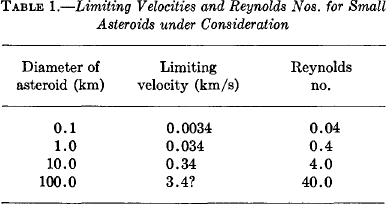No CrossRef data available.
Published online by Cambridge University Press: 12 April 2016
It is shown that aerodynamic forces could have played a significant role in the selective accumulation of chondrules on asteroids that are moving with respect to the gas in a primeval solar nebula. Particles smaller than millimeter chondrules would sweep by an asteroid moving more slowly than a critical velocity, while larger particles could be accumulated by impact. Theory and calculation cover the case of subsonic velocity and asteroidal diameter up to 50 km independent of the nebular density from 10-8 to 10-6 g cm-3 or higher for smaller asteroids, as illustrated in table 1.

The calculations are based on a solar mixture of materials at T = 550° K and on Stokes’ law of aerodynamic drag, which fails for nebular densities below about 10-8 g cm-3 for millimeter sized spheres. Below this limit the limiting velocity falls off proportionally to gas density. Note that the accretion rates for small particles can be severely restricted because of aerodynamic flow at small asteroidal velocities with respect to the gas. Near and above the critical velocity the asteroidal gravity does not materially add to the accretion rate regardless of asteroidal mass.
The complete paper has been published in Physical Studies of the Minor Planets, NASA SP-267, edited by Tom Gehrels, pp. 251-256, 1971.
* The complete paper has been published in Physical Studies of the Minor Planets, NASA SP-267, edited by Tom Gehrels, pp. 251-256, 1971.